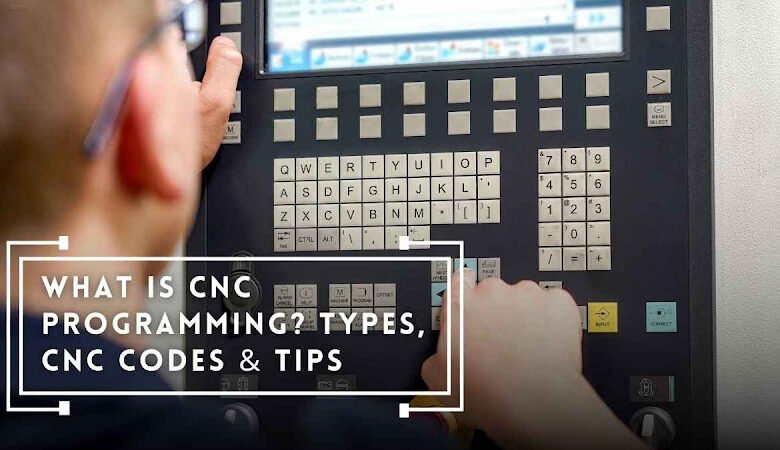What Is CNC Programming? Types, CNC Codes & Tips

CNC programming encompasses the conversion of human design into the execution format by automated machines. It takes the CAD models and translates these into instructions that CNC machines follow and brings ideas into real-time products.
In general, CNC technologies like CNC milling, CNC drilling, CNC turning, or CNC routing are mainly operated based on CNC programming to provide precision and repetitiveness in manufacturing. Customers looking for custom parts with specific dimensions, and tolerance requirements can greatly benefit from a basic understanding of CNC programming.
In this guide, we will discuss CNC programming, its working, and types and provide valuable insights for writing your CNC programs.
What Is CNC Programming?
CNC programming is a coding process involving software to produce instructions for CNC machines. These instructions control the machine’s movement and allow you to perform operations flawlessly. These codes are typically used in common CNC lathes and milling machines to achieve accuracy in complicated designs. Although, it requires precision when dealing with both machines and tools.
There are generally two types of codes involved in CNC machining: G-codes and M-codes. These codes are used to command processes.
- G codes: It help position the cutting tools. (Read more information about what is g code)
- M codes: It controls other activities, such as tool orientation.
Furthermore, there are also numbers and letters like S, T, D, and F which allow you to regulate the facets like speed and feed rates, and tool numbering. It helps you eliminate the turnover of pthe roduct in question.
How does CNC programming Work?
Here’s a breakdown of the automated CNC programming process:
Step 1: Part Design
CNC programming starts with establishing a 3D model on the CAD software. The model defines the part features, details, and dimensions. So, if your project demands precise dimensions even in microns, CNC programming allows you to achieve with ease.
Step 2: Produce Tool Paths
Next, the CAM software generates the tool tool paths. These paths determine the tool’s movement, its material, and its rotating velocities.
Step 3: Produce the CNC Program
The programmer uses the G-code to develop the CNC program. The program contains data like cutting depth and start position to guide the CNC machine.
Step 4: CNC Machine Setup
Before executing the code, CNC machines need an appropriate setup. It includes safety checks, coolant, workpiece holding mechanisms, feed rate, and cutting speeds to make sure they are all synchronized with the CNC program.
Step 5: Execution of Program
After the machine is set up, the program is started, and the CNC machine goes through the instructions. The process is controlled by the operator while adjustments are made in between to obtain desired outcomes.
Examples of CNC Programming Software
The following are popular software programs used in CNC programming:
- Mastercam
- Vectric
- Mexican
- Fusion 360
- Solidworks
- Carbide 3D
- HyperMILL
CNC Programming Codes
The automated CNC programming control uses various codes to direct the machine functionality, and every code acts as a command.
D-Codes
D-codes define the tool offset. The offset is the distance between the edge and the center of one tool, measured in terms of periphery or circumference.
F-Codes
F-codes determine feed rates. A feed rate determines how fast a cutting tool will move during operation.
G-Codes
These codes are used as geometric codes to control the motion required from a CNC machine, such as the circular feed and rapid traverse.
M-Codes
M-codes are miscellaneous commands. These are required for nongeometric operations like waiting and stopping the machine.
N-Codes
Relatively, N-codes are used to mark blocks of the CNC code. These are useful and invariable, especially if built by hand.
S-Codes
S-codes explain spindle speed and surface speed, primarily in RPM, and work with M03 and M04.
T-Codes
T-codes call off and select tools. These are used together with the M6 change tool.
Writing Your CNC Code: How Do You Program a CNC Machine?
The generation of CNC code is not a complicated task. But it can’t be generated randomly as it requires a certain method to be followed. Here’s a straightforward roadmap or guide to help you get started:
1. Export the Model
It always starts with transferring your CAD file into the respective CAM software. Some modern programs have linked packages that allow an easy transition from one system to another.
2. Create Tool Paths
Next, in the CAM software, you need to generate tool paths. These demonstrate how the cutting tool is required to shift while cutting.
3. Verify Tool Paths
Always verify your tool paths by simulating them before moving to the machine. This step allows you to negate the paths are correct, and no errors will likely happen throughout the process.
4. Download to the CNC Machine
Lastly, check the tool paths twice. Afterward, the CNC code is uploaded to the CNC machine by using a flash drive. The code will be input into the machine and the machine begins to chisel out the machining details.
Types of CNC Programming
CNC programming is done through primarily three methods: Manual, computer-aided manufacturing, and conversational programming. Each one has its benefits and limitations and depends on the actual task difficulty.
Manual CNC Programming
Manual CNC programming can only be done by entering instructions into the CNC machine directly through the console. This method requires certain skills as regards the CNC machine and G-code programming language.
Key Steps in Manual Programming:
- Define tooling path and machining operations in terms of the CNC coordinate system.
- Write the CNC program in G-code.
- Input the program into the machine controller.
The primary benefit of manual programming is that it tends to provide full control over the machining procedure. But it’s extremely slow and not exempt from human errors. Additionally, it is controlled solely by programmers and includes feed rates, tool choices, and rotations.
Pros of Manual CNC Programming:
- Complete Control: Programmers have control over all points of differences including feed rates and cycle times aspects.
- Require Detailed Process Understanding: Promotes the knowledge of the application and the machinery.
- Flexibility: Optimal for diverse tasks or particularly for jobs that are simple and custom.
Cons of Manual CNC Programming:
- Time-Consuming: Slower as compared to other methods and requires more manpower.
- Error-Prone: Keying in raises the mistakes and errors in the machining process.
- Limited Error Detection: There is no autonomous mechanism to notify the programmer about possible problem occurrences.
Computer Aided Manufacturing (CAM) Programming
CAM programming is more contemporary and frequently used than CNC programming. It is preferable for complicated and intricate parts. Additionally, it allows you to directly translates code into a tool path by employing some specialized software.
Key Steps in CAM Programming:
- Design the part using CAD software.
- Move the design to CAM software for tool path generation.
- Generate G-code and feed it to the CNC machine.
CAM software is more effective in programming than manual processes by minimizing the time and effort required in the process. Moreover, it enables high-speed programming of sophisticated forms directly to the CNC machine tool and has simulation tools for checking the sequence to avoid possible mistakes.
Pros of CAM CNC Programming:
- Faster Programming: Cut down the time it takes to generate tool paths as well as G-code.
- Error Detection: A vast majority of CAM systems enable simulation to negate errors that could appear during a machining operation. So, helps you detect issues before they happen.
Cons of CAM CNC Programming:
- Cost: The implementation of CAM technology requires an outlay of cash, which may be significant.
- Learning Curve: The CAD and CAM software systems are central, and programmers should be conversant.
- Limited Control: Most of the program operations are handled by software, which reduces the manual control of a few parameters.
Conversational CNC Programming
Conversational programming is integrated into some CNC machines. It is relatively easy to use, used by beginners or those not well versed in G-code operators. In addition, it simplifies the task by asking the programmer to identify the configuration of the machine through a set of questions.
Key Features of Conversational Programming:
- User-Friendly Interface: Using the ‘wizard’ option the CNC machine enters into a series of instructions requiring an input to be made by the operator for certain parameters such as material, method of machining, and tools.
- Simplified Setup: Rather than coding in G-code, the programmer fills out forms that question the program, and it supplies the necessary G-code.
Conversational programming limits you because it does not work with complicated geometry and involves tool paths.
Pros of Conversational CNC Programming:
- Ease of Use: It can be operated by persons with no G-code knowledge. Thus, first-time users can control it easily.
- Quick Setup: Recommended for low-complexity work when quick and small parts are desired.
Cons of Conversational CNC Programming:
- Conversational CNC Programming is limited to Complex Parts
- Machine Dependent: Only used on CNC-affectation equipment that has a conversation proficiency.
Summary
In conclusion, CNC programming can be stated as the mediator of the gap between humans and machines. It translates the CAD files/models to tell CNC machines to carry out operations. It helps businesses design products that are nearly perfect with minimal flaws. Whether, you work in the automotive, aircraft, or electronics sectors, programming effectively brings your concept into tangible parts saving both your time and costs.
Want more untold stories of everyday strength and quiet impact? Explore them at Heightmag.com




